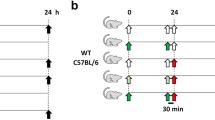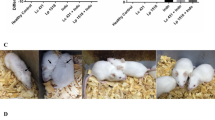Abstract
The molecular basis of the injurious actions of non-steroidal anti-inflammatory drugs (NSAIDs) on the gastrointestinal (GI) tract is only partly understood. In this study we have obtained evidence, employing both in vitro and in vivo systems, that five NSAIDs have the ability to form a chemical association with zwitterionic phospholipids. Since this same class of phospholipids line the luminal aspects of the mucus gel layer to provide it with non-wettable properties, this intermolecular association may be the mechanism by which NSAIDs attenuate the hydrophobic barrier properties of the upper GI tract. Preassociating a number of NSAIDs with exogenous zwitterionic phospholipids prevented this increase in surface wettability of the mucus gel layer and protected rats against the injurious GI side-effects of these drugs, while enhancing their lipid permeability, antipyretic and anti-inflammatory activity.
This is a preview of subscription content, access via your institution
Access options
Subscribe to this journal
Receive 12 print issues and online access
$209.00 per year
only $17.42 per issue
Buy this article
- Purchase on Springer Link
- Instant access to full article PDF
Prices may be subject to local taxes which are calculated during checkout
Similar content being viewed by others
References
Rainsford, K.D. Anti-inflammatory and Anti-rheumatic Drugs I, (CRC Press, Boca Raton, FL, (1985).
Alexander, A.M., Veitch, G.B.A. & Wood, J.B. Anti-rheumatic and analgesic drug usage and acute gastro-intestinal bleeding in elderly patients. J. clin. Hosp. Pharm. 10, 89–93 (1985).
Jolobe, O.M.P. & Montgomery, R.D. Changing clinical pattern of gastric ulcer: Are anti-inflammatory drugs involved? Digestion 29, 164–170 (1984).
Rainsford, K.D. Mechanism of gastrointestinal toxicity of non-steroidal anti-inflammatory drugs. Scand. J. Gastroenterol. 24 (suppl. 163), 9–16 (1989).
Graham, D.Y. Prevention of gastroduodenal injury induced by chronic nonsteroidal anti-inflammatory drug therapy. Gastroenterology 96, 675–681 (1989).
Allison, M.C., Howatson, A.G., Torrance, C.J., Lee, F.D. & Russell, R.I. Gastrointestinal damage associated with the use of nonsteroidal anti-inflammatory drugs New Engl. J. Med. 32, 749–754 (1992).
Alpsten, M., Bogentoft, C., Ekenved, G. & Solvell, L. Gastric emptying and absorption of acetylsalicylic acid administered as enteric-coated microgranules. Eur. J. clin. Pharmac. 22, 57–61, (1982).
Mojaverian, P., Rocci, M.L. Jr, Conner, D.P., Abrams, W.B. & Vlasses, P.H. Effect of food on the absorption of enteric-coated aspirin: Correlation with gastric residence time. Clin. Pharmac. Ther. 41, 11–17 (1987).
Whittle, B.J.R., Higgs, G.A., Eakins, K.E., Moncada, S. & Vane, J.R. Selective inhibition of prostaglandin production in inflammatory exudates and gastric mucosa. Nature 284, 271–273 (1980).
Whittle, B.J.R. Temoral relationship between cyclooxygenase inhibition, as measured by prostacyclin biosynthesis and the gastrointestinal damage induced by indomethacin in the rat. Gastroenterology 80, 94–98 (1981).
Ligumsky, M., Grossman, M.I. & Kauffman, G.L. Jr Endogenous gastric mucosal prostaglandins: Their role in mucosal integrity. Am. J. Physiol. 242, G337–341 (1982).
McCormack, K. & Brune, K. Classical absorption theory and the development of gastric mucosal damage associated with non-steroidal anti-inflammatory drugs. Archs. Toxicol. 60, 261–269 (1987).
Hills, B.A., Butler, B.D. & Lichtenberger, L.M. Gastric mucosal barrier: The hydrophobic lining to the lumen of the stomach. Am. J. Physiol. 244, G561–G568 (1983).
Goddard, P.J., Hills, B.A. & Lichtenberger, L.M. Does aspirin damage the canine gastric mucosa by reducing its surface hydrophobicity? Am. J. Physiol. 252, G421–G430 (1987).
Goddard, P.J., Kao, Y.-C. & Lichtenberger, L.M. Luminal surface hydrophobicity of canine gastric mucosa is dependent on a surface mucous gel. Gastroenterology 98, 361–370 (1990).
Kao, Y.-C., Goddard, P.J. & Lichtenberger, L.M. Morphological effects of aspirin and prostaglandin on the canine gastric mucosal surface: Analysis with a phospholipid cytochemical stain. Gastroenterology 98, 592–606 (1990).
Kao, Y.-C., & Lichtenberger, L.M. Phospholipid- and neutral-lipid containing organelles of rat gastroduodenal mucous cells. Gastroenterology 101, 7–21 (1991).
Kao, Y.-C., & Lichtenberger, L.M. Effect of 16,16 dimethyl prostaglandin E2 on the lipidic organelles of rat gastric surface mucous cells. Gastroenterology 104, 103–113 (1993).
Adams, S.S., Hebborn, P. & Nicholson, J.S. Some aspects of the pharmacology of ibufenac, a non-steroidal anti-inflammatory agent. J. Pharm. Pharmac. 20, 305–312 (1968).
Ucelay, M., Lasheras, B. & Cenarruzabeitia, E. Pharmacological study of the new non-steroidal anti-inflammatory agent, 4′-Acetamidophenyl-2-(5′-p-toluyl-1′-methylpyrrole) acetate. Arzheim–Forsch/Drug Res. 38, 546–551 (1988).
Castro, G.A., Malone, C. & Smith, S. Systemic anti-inflammatory effect associated with enteric trichinellosis in the rat. J. Parasit. 66, 407–412 (1980).
Lichtenberger, L.M., Graziani, L.A., Dial, E.J., Butler, B.D. & Hills, B.A. Role of surface-active phospholipids in gastric cytoprotection. Science 219, 1327–1329 (1983)
Chen, et al. Gastroenterology 104, A53 (1993).
Clatworthy, A.L., Castro, G.A., Budelmann, B.U. & Walters, E.T. Induction of a cellular defense reaction is accompanied by an increase in sensory neuron excitability in Aplysia . J. Neurosci. 14, 3263–3270 (1994).
Author information
Authors and Affiliations
Rights and permissions
About this article
Cite this article
Lichtenberger, L., Wang, ZM., Romero, J. et al. Non-steroidal anti-inflammatory drugs (NSAIDs) associate with zwitterionic phospholipids: Insight into the mechanism and reversal of NSAID-induced gastrointestinal injury. Nat Med 1, 154–158 (1995). https://doi.org/10.1038/nm0295-154
Received:
Accepted:
Issue Date:
DOI: https://doi.org/10.1038/nm0295-154
This article is cited by
-
Machine learning enabled orthogonal camera goniometry for accurate and robust contact angle measurements
Scientific Reports (2023)
-
Pharmacokinetic and pharmacodynamic profiles of a novel phospholipid-aspirin complex liquid formulation and low dose enteric-coated aspirin: results from a prospective, randomized, crossover study
Journal of Thrombosis and Thrombolysis (2022)
-
Antiulcer activity of ethanolic leaf extract of Capparis zeylanica against chemically induced ulcers
Future Journal of Pharmaceutical Sciences (2021)
-
Sulindac plus a phospholipid is effective for polyp reduction and safer than sulindac alone in a mouse model of colorectal cancer development
BMC Cancer (2020)
-
Bioavailability of aspirin in fasted and fed states of a novel pharmaceutical lipid aspirin complex formulation
Journal of Thrombosis and Thrombolysis (2020)



